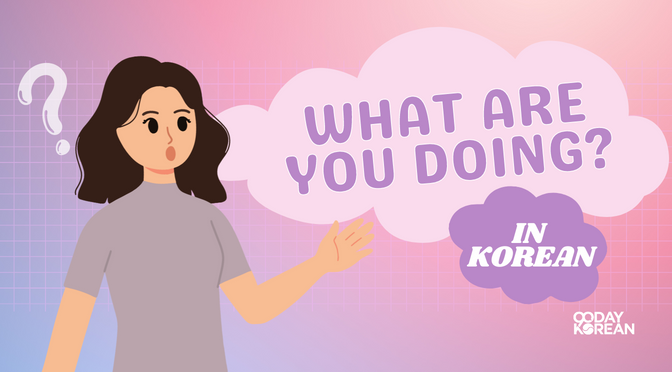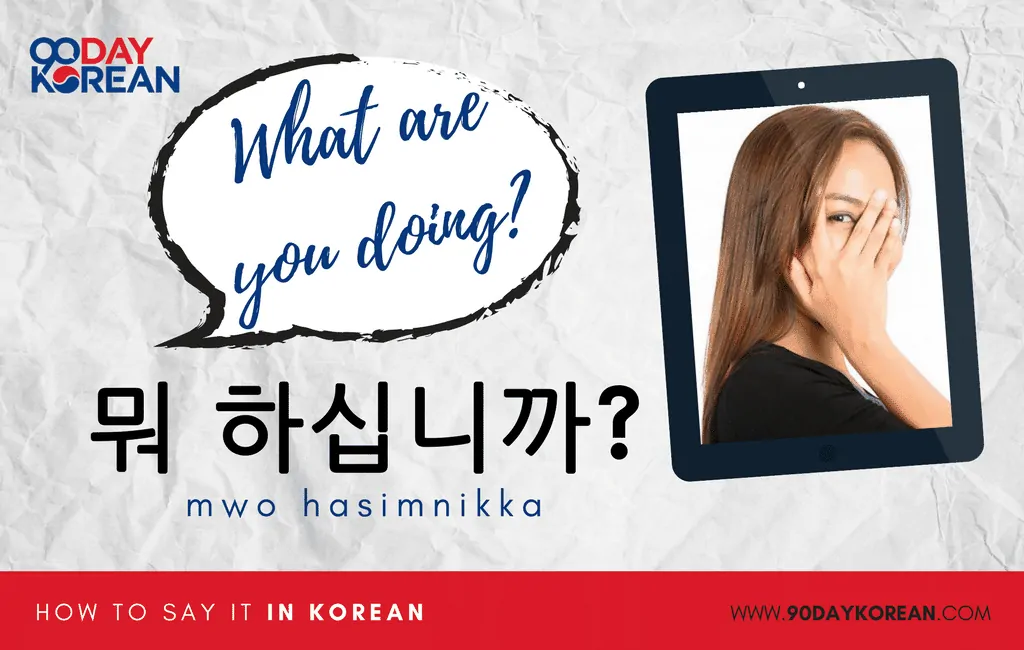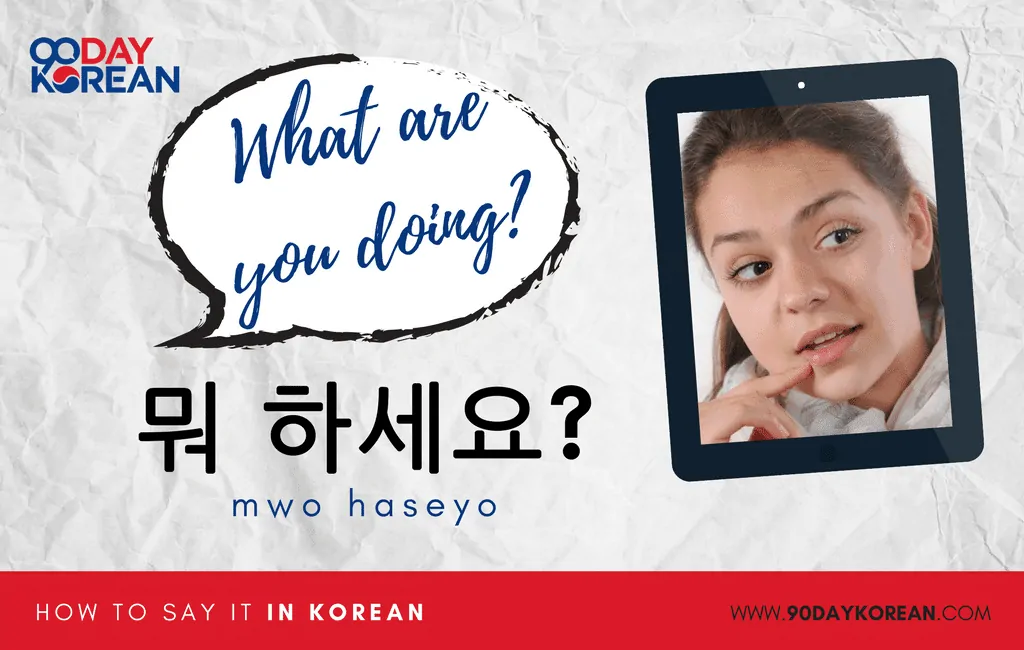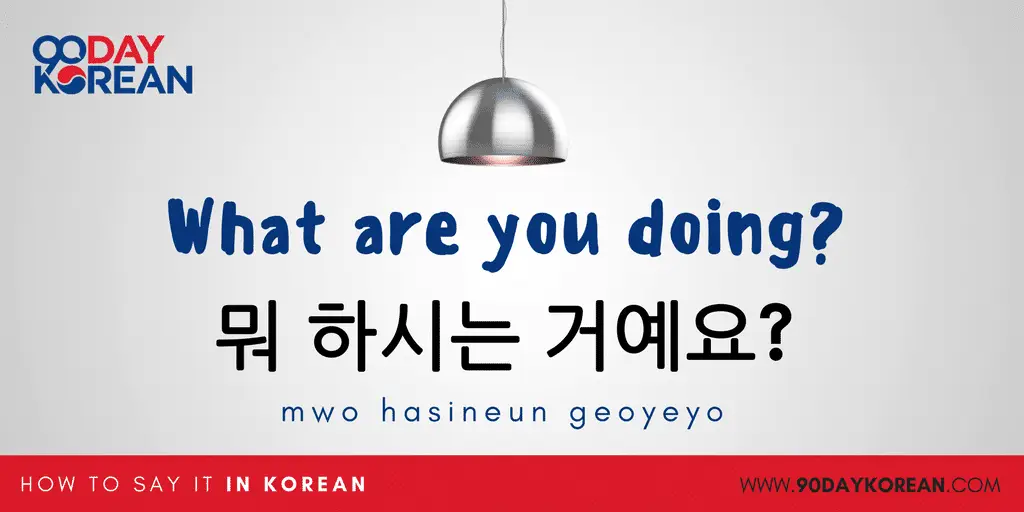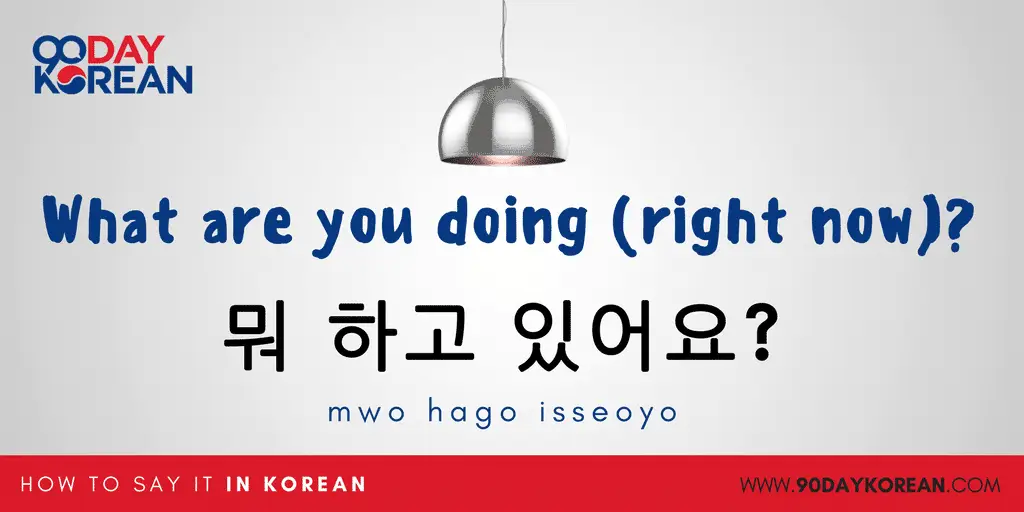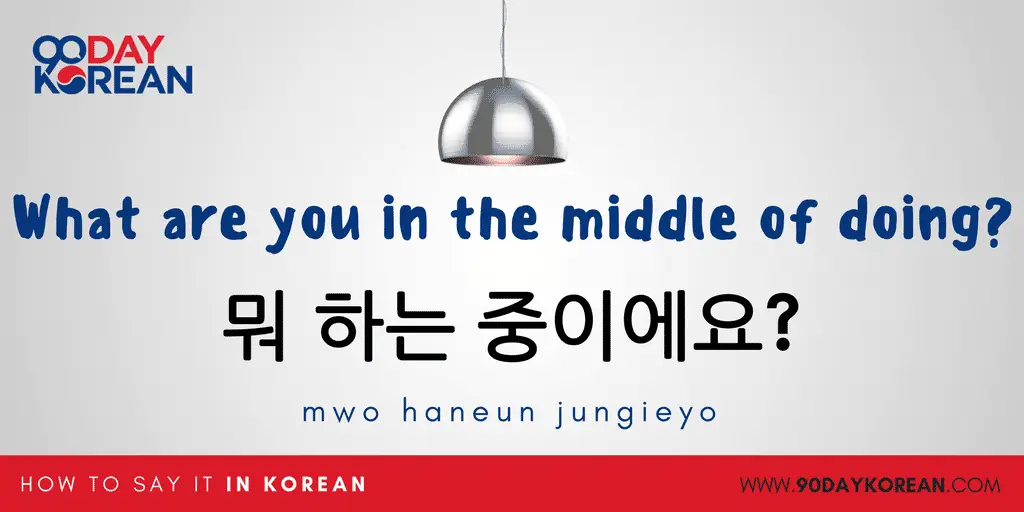It is always good to know a few conversation starters when learning a new language. Knowing how to say “What are you doing?” in Korean will help you start conversations. Not only will this help you get more practice at speaking Korean, but it will also help you strengthen your friendships with Koreans!
We’ve included a FREE PDF version of this lesson you can take with you on the go. Check it out below:
Let’s get started!
Contents
- 1 “What are you doing?” in Korean
- 2 Formal “What Are You Doing?” in Korean
- 2.1 1. 뭐 하십니까? (mwo hasimnikka)
- 3 Standard “What Are You Doing?” in Korean
- 3.1 1. 뭐 하세요? (mwo haseyo)
- 3.2
- 3.3 2. 뭐 해요? (mwo haeyo)
- 4 Informal “What Are You Doing?” in Korean
- 4.1 1. 뭐 해? (mwo hae)
- 4.2
- 4.3 2. 뭐 하니? (mwo hani)
- 5 Other ways to say “What Are You Doing?” in Korean
- 5.1 1. 뭐 하시는 거예요? (mwo hasineun geoyeyo)
- 5.2 2. 뭐 하는 거야? (mwo haneun geoya)
- 5.3 3. 뭐 하고 있어요? (mwo hago isseoyo)
- 5.4 4. 뭐 하고 있어? (mwo hago isseo)
- 5.5 5. 뭐 하는 중이에요? (mwo haneun jungieyo)
- 5.6 6. 뭐 하는 중이야? (mwo haneun jungiya)
- 6 A Word of Caution About Romanization
There are many different ways to say “What are you doing?” in Korean, but they all have two things in common. The first is the word 뭐 (mwo), which means “what.”
The second thing that they have in common is the use of the verb 하다 (hada), which means “to do.”
Formal “What Are You Doing?” in Korean
In these situations, you are unlikely to want to ask somebody what they are doing. However, if you do want to ask them, then be very polite about it.
Here’s how you can ask, “what are you doing” in a formal way.
1. 뭐 하십니까? (mwo hasimnikka)
Formal Korean should be used when making announcements, doing presentations, or during an interview.
Use 하십니까 (hasimnikka) rather than 합니까 (hamnikka) to make your question sound politer.
Example:
죄송합니다, 그런데 뭐 하십니까? (joesonghamnida, geureonde mwo hasimnikka)
Sorry, but what are you doing?
Can’t read Korean yet? Click here to learn for free in about 60 minutes!
Standard “What Are You Doing?” in Korean
There are two ways to say, “What are you doing?” in Korean. You can use these expressions when talking to people who are older or not particularly close to you.
1. 뭐 하세요? (mwo haseyo)
The first way is by adding 하세요 (haseyo) to “what” or 뭐 (mwo). Using 하세요 (haseyo) is a more polite way of asking questions than using 해요 (haeyo), which will be discussed below.
This form can be used when asking other questions, too, such as 어디에 사세요? (eodie saseyo), which means “Where do you live?.”
2. 뭐 해요? (mwo haeyo)
The second way is with the use of 해요 (haeyo). You should only use the 세 (se) form when referring to others, never when referring to yourself. Therefore, you should answer the question “what are you doing?” by using the simple 해요 (haeyo) form of 하다 (hada).
Example:
A: 지금 뭐 하세요? (jigeum mwo haseyo)
What are you doing now?
B: 일본어를 공부해요. (ilboneoreul gongbuhaeyo)
I’m studying Japanese.
Informal “What Are You Doing?” in Korean
Lastly, there are also two ways to express this question informally. You can use these expressions with people who are close to you and who are of a similar or younger age.
1. 뭐 해? (mwo hae)
To say, “What are you doing?” in Korean informally, you can drop the 요 (yo) and say 뭐 해? (mwo hae) instead.
2. 뭐 하니? (mwo hani)
The other way to say “What are you doing?” in Korean is 뭐 하니? (mwo hani).
Example:
A: 뭐 해? (mwo hae)
What are you doing?
B: 수영해 (suyeonghae)
I’m swimming.
Other ways to say “What Are You Doing?” in Korean
If you are just starting out, then learning the above phrases will be fine. If you want to know other ways of saying “What are you doing?” in Korean, then keep reading!
Note that the following phrases have all been written in the standard politeness level first and the informal politeness level second.
1. 뭐 하시는 거예요? (mwo hasineun geoyeyo)
2. 뭐 하는 거야? (mwo haneun geoya)
This is a common way of saying, “What are you doing?” in Korean.
3. 뭐 하고 있어요? (mwo hago isseoyo)
4. 뭐 하고 있어? (mwo hago isseo)
This uses the present progressive tense, so literally means “what are you doing (right now)?”
5. 뭐 하는 중이에요? (mwo haneun jungieyo)
6. 뭐 하는 중이야? (mwo haneun jungiya)
This literally means, “What are you in the middle of doing?”
A Word of Caution About Romanization
If you only intend on learning one or two words in Korean, then you can get away with just reading the romanization of Korean words. However, if you want to go deeper, the first step is to learn the Korean alphabet, which is known as Hangul. This will help you understand the structure of the language and notice patterns, as well as improve your pronunciation and reading.
Take our full Korean course to get all the help you need while studying the Korean language. This will help you move from just knowing a few words and phrases to being able to converse in the language.
Now that you know how to say “What are you doing?” in Korean use this phrase to start conversations with your Korean friends!
Dialogue
Want to Understand & Master the Korean Dialogue 100%?
Get a breakdown of the dialogue and translations instantly with the Premium line-by-line Audio. Sign up for your Free Lifetime Account Now and get 7 Days of Premium Access including this feature.
By clicking Join Now, you agree to our
Terms of Use,
Privacy Policy,
and to receive our email communications, which you may opt out at any time.
Vocabulary
Learn New Words FAST with this Lesson’s Vocab Review List
Get this lesson’s key vocab, their translations and pronunciations. Sign up for your Free Lifetime Account Now and get 7 Days of Premium Access including this feature.
By clicking Join Now, you agree to our
Terms of Use,
Privacy Policy,
and to receive our email communications, which you may opt out at any time.
Lesson Notes
Unlock In-Depth Explanations & Exclusive Takeaways with Printable Lesson Notes
Unlock Lesson Notes and Transcripts for every single lesson. Sign Up for a Free Lifetime Account and Get 7 Days of Premium Access.
By clicking Join Now, you agree to our
Terms of Use,
Privacy Policy,
and to receive our email communications, which you may opt out at any time.
Lesson Transcript
| Introduction |
| Becky: What are you doing? In this lesson, you’ll learn how to ask what someone is doing in Korean. |
| Body |
| Becky: Here’s the informal way to ask ‘What are you doing?’ in Korean. |
| Kyejin: [Normal] 뭐 하고 있어요?(mwo hago isseyo?) |
| Becky: First is a word meaning ‘what ‘ |
| Kyejin: [Normal] 뭐 [Slow] 뭐 (mwo ) |
| Becky: Last is the phrase meaning ‘are you doing?’ |
| Kyejin: [Normal] 하고 있어요 [Slow] 하고 있어요(hago isseyo) |
| Becky: Note the rising intonation. Listen again to the informal question meaning ‘What are you doing?’ |
| Kyejin: [Slow] 뭐 하고 있어요? [Normal] 뭐 하고 있어요? |
| Becky: Now, imagine you’re speaking to a stranger. Here’s the formal way to ask, ‘What are you doing?’ |
| Kyejin: [Normal] 뭐 하고 계십니까?(mwo hago gyesimnikka?) |
| Becky: First is a word meaning ‘what ‘ |
| Kyejin: [Normal] 뭐 [Slow] 뭐 (mwo ) |
| Becky: Last is the word meaning ‘are you doing’ |
| Kyejin: [Normal] 하고 계십니까 [Slow] 하고 계십니까(hago gyesimnikka) |
| Becky: Note again the rising intonation. Listen again to the formal question meaning ‘What are you doing?’ |
| Kyejin: [Slow] 뭐 하고 계십니까? [Normal] 뭐 하고 계십니까? |
| Becky: Here’s a response meaning ‘I am studying.’ |
| Kyejin: [Normal] 공부하고 있어요.(gongbuhago isseoyo.) |
| Becky: First is a word meaning ‘study’ |
| Kyejin: [Normal] 공부 [Slow] 공부(gongbu) |
| Becky: Last is the phrase meaning ‘I am doing’ |
| Kyejin: [Normal] 하고 있어요 [Slow] 하고 있어요(hago isseoyo) |
| Becky: Listen again to the response, ‘I am studying.’ |
| Kyejin: [Slow] 공부하고 있어요. [Normal] 공부하고 있어요. |
| Becky: Here’s a response meaning, ‘I’m doing nothing special.’ |
| Kyejin: [Normal] 그냥 있습니다.(geunyang itsseumnida.) |
| Becky: First is a word meaning ‘just ‘ |
| Kyejin: [Normal] 그냥 [Slow] 그냥 (geunyang ) |
| Becky: Last is the word meaning ‘is, am, are’ |
| Kyejin: [Normal] 있습니다 [Slow] 있습니다(itsseumnida) |
| Becky: Listen again to the response, ‘I’m doing nothing special.’ |
| Kyejin: [Slow] 그냥 있습니다. [Normal] 그냥 있습니다. |
| Cultural Insight |
| Becky: Now it’s time for a quick cultural insight. |
| Kyejin: 하다(hada) means «to do», and it’s a very useful word. You can make so many verbs by combining a noun with 하다. Many Korean nouns that indicate or describe an action or a behavior can be combined with 하다. |
Outro |
|---|
| Becky: And that’s all for this lesson. Don’t forget to check out the lesson notes, and we’ll see you in the next lesson! |
How do you answer what are you doing in Korean?
뭐 해요? (mwo haeyo)
Using 하세요 (haseyo) is a more polite way of asking questions than using 해요 (haeyo). Therefore, you should answer the question ‘what are you doing? ‘ by using the simple ‘해요 (haeyo)’ form of 하다 (hada).
What does Juseyo mean?
Juseyo (Joo-se-yo), Jebal – both words mean “please” but they are used in different situations. Juseyo is like your more common kind of please or if you are asking for something. For example, if you are eating at a restaurant and want more kimchi, you say, “Jogiyo (Excuse me), kimchi juseyo”.
What does Imnida mean?
imnida 입니다 is the present tense of “To be (is/are/am)” in Honorific form. You will often hear it in a Declarative statement.
How do you say cool in Korean slang?
If we are talking about a person, a quality about them, or something they are doing as being ‘cool‘, the right word to use is 멋있어요 (meosisseoyo). You can also informally use it just in its basic form, which is 멋있다 (meositta).
What does Nim mean in Korean?
The word 님 (nim) in Korean could be roughly translated to “Mr.” or “Madam” in English. It is one of the most common honorifics used in the Korean language. 씨 (ssi) This suffix is used to address people that are roughly on the same level of the social hierarchy.
Can a girl say Hyung?
“Hyung” means “Elder Brother” and this term is used exclusively by a male sibling. “Oppa” means “Elder Brother” and is used exclusively by a female sibling. “Oppa” carries a sense of endearment—you see it is a term that was supposed to be used by the biological sibling.
Is Oppa flirty?
With the right inflection, oppa can be a really flirtatious way for a girl to let a guy know she’s into him. And, once in a relationship, the girl will continue to refer to her beau as oppa. They often think oppa means “boyfriend,” but that’s not the case.
What does Sunbae mean?
Sunbae(선배, 先輩) is a word that refers to people with more experience (at work, school, etc), and hoobae(후배, 後輩) refers to people with less experience. Generally, hoobaes have to use jondaetmal(존댓말, honorific language) to sunbaes, meaning they have to speak very politely and treat them with respect.
What does Daebak mean?
대박 – (Daebak) Meaning: That’s awesome! Stars in Korean dramas and variety shows use this word frequently. It describes when something is awesome or it’s a way of showing enthusiasm.
Is Sunbae a boy or girl?
Can be used for both guys & girls. Sunbae does not necessarily have to be older. You adress someone like that if the person has more experience in certain job, for example music industry.
Can you call your boyfriend Sunbae?
자기 is an interesting term because the word can also be used to refer to “oneself.” So it might speak to the level of closeness and intimacy you have with your partner. If the person is called your better “half,” then it’d be perfectly fine to use the same word you‘d use to refer to yourself.
Is noona flirty?
It could be a flirt, but generally when a girl calls a guy who is older than her, say Oppa. and when a guy calls a girl who is older than him, say Noona.
What do you call a Korean boyfriend?
Korean terms of endearment you will often hear in K-dramas
- Aein – “Sweetheart” / “Lover”
- Jagi / Jagiya – “Honey” / “Darling”
- Aegiya – “Baby” / “Babe”
- Oppa – An older brother to a younger woman.
- Nae sarang – “My love”
- Yeobo – “Darling” / “Honey” (for married couples)
- Naekkeo – “Mine”
How can I call my boyfriend?
What name can I call my lover?
Examples of Cute Nicknames For Boyfriend
- Sweetie – The perfect pet name for a sweet boyfriend.
- Honeybun – A cute name to call your adorable boyfriend.
- Sweetie Pie – A romantic nickname for your male lover.
- Baboo – a funny nickname for a cute and adorable boy.
- Cuddle Bunny – A sweet pet name for your cuddle partner.
Hi, it’s your Korean teacher Jun. Everybody has a friend right? Even if it’s imaginary… *tear drops….* lol no. I’ll be serious. So, maybe this is the most common and simple question you can make to a person who you don’t know how to keep the conversation lolol. That’s sad a bit and that’s why we are going to learn how to ask what are you doing in Korean right now!
Warm Up Your Brain
Knock knock hello brain? What are you doing? You seem like sleeping for 20 years and I need you to wake up… please let me be smart once PLEASNEOTWNGOIRENHO lol. I know you guys are smart. Don’t look at me weird. >:I
How To Say What Are You Doing? In Korean
뭐해요?
[mwoheyo]
What are you doing?
I think this question is 100% necessary when you reach some point where is really hard to make any fun stuff to talk about. it’s really a sad question because people say it only when they don’t have much things to talk about. It feels like ‘sad are you doing’ lolol. When you use this phrase, make sure if you use -해요 speech style because it can sound a bit weird with another.
With Other Tenses
If you’ve studied Korean grammar with KoreanJun, then you might notice I said 뭐해요 in present tense, not present progressive tense. Yes. Korean uses present tense as present progressive tense too and 뭐해요 is much more common in present tense.
If you want to ask it in present progressive tense. It’s ‘뭐하고 있어요?‘
Remember, 뭐해요 and 뭐하고 있어요 are exactly same.
How To Use It
A: 준씨 뭐해요?
What’s up Jun?
B: 책 읽어요
I’m reading a book
A: 지금 뭐해요?
What are you doing now?
B: 치킨 먹어요
I’m eating fried chicken
A: 뭐하고 있어요?
What are you doing Jun?
B: 신발 핥고 있어요 ㅎㅎ
I’m licking my shoe 🙂
What’s Up? In Korean
Korean language doesn’t have a same expression as what’s up. So 뭐해요 functions exactly same. A lot of native Koreans start a conversation with 뭐해 instead of 안녕 when they are close enough to the person and talk to each other often.
* 뭐해? : An informal version of 뭐해요? That you can use to really close friends who are same years old to you in Korean age
뭐해요? With Spacing
Some students space between 뭐 and 해요 because both are separated words. However, once it’s combined to make a new word. You shouldn’t space them
뭐 해요? (Wrong)
뭐해요? (Correct)
What The Hell Are You Doing?
Yeah, you can also use this phrase like ‘WHAT ARE YOU DOING?’. But Korean language is weirdly developed for this (lol) with no reason. So, 뭐해요 doesn’t have an impact like English’s.
아니 지금 뭐하는 거예요?
What the fuck are you doing?
Learn It Together
-씨 : Korean title to call other person
책 : Book
읽다 : Read
지금 : Now
치킨 : Fried chicken
먹다 : Eat
신발 : Shoe / Shoes
핥다 : Lick
⠂Made in Korea
⠂Made of 100% Korean
⠂Adjusted as 100% Korean
⠂Ready to active Professor Mode
⠂Love to make people laugh as much as I love to teach
40%
1:1 MASTER CLASS.
DISCOUNT
DON’T MISS
THE SPECIAL OFFER
This Course Was $15
$15, maybe it’s nothing that you can earn after a couple of hours of labor. Or, maybe you have to work for full days to earn it only because of where you were born. And $15, It’s the average price of Korean textbooks. Life is unfair. But that’s why we can help each other, we are helping each other.
This Is Why I Published My Textbook For Free
I didn’t make it possible alone. A lot of people helped me and encouraged me and, of course, support me. I really appreciate my supporters, Team Junicorns. If my tutorials are helpful or if you want to share the same dream, join the Team Junicorns and support me to keep going.
Join Korean Jun Community!
Go Team Junicorn!
Why Korean Jun?
Super Real Korean
Do you really use some words such as ‘a little boy’, ‘lions’ or ‘carrot’ everyday? So, I’m not going to teach those.
The Magical POWER
The ancient magical language from the far far land. Learn Korean and it’ll make you look 500% more charming.
No Fake, No False
Some wise man in the internet age said ‘Don’t believe the internet’. However, in Korean Jun, any tutorial is triple checked! Accurate than any textbooks.
Build Korean Brain
Instead of forcing you to memorize words. I’m going to make you understand how Korean grammar really works. Learn Korean grammar triple faster!
Super Duper High-Quality
This is not just an internet free learning material. I spent years for the Core Grammar course.
Kimchi Cloud | December 23, 2015 | No Comments | Random Phrases
What Are You Doing? In Korean
In this lesson learn how to say ‘What Are You Doing?’ In Korean. For this you use the phrase:
뭐해?
[mwo hae?]
What are you doing?
For more stuff like this, check out our Simple Korean Phrases archive!
Please like or share if you found this useful, and if you have any questions, make sure to leave a comment below!
By: Kimchi Cloud
—Comments are temporarily disabled. We apologize for the inconvenience.—

